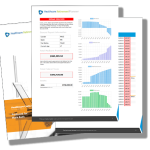Figuring out the IRA vs 401k puzzle can seem like a daunting task for many professionals and investors.
The intricacies of these retirement savings options often leave individuals perplexed and unsure about their financial future.
Navigating the complexities of IRA vs 401(k) is a must for those who wish to make the most out of their retirement savings and achieve their financial goals.
In fact, when it comes to planning for your golden years, knowing how to navigate the complexities of IRA vs 401k can make all the difference in achieving your financial goals.
Unraveling the Complexities of Traditional IRA vs 401(k)
The world of retirement savings is vast, encompassing numerous investment options such as Traditional IRAs (Individual Retirement Accounts) and employer-sponsored plans like a typical company’s standard version – often referred to as a 401(k). These tax-advantaged retirement accounts are essential for those wanting to ensure a comfortable life after they stop working. Yet, understanding their intricacies can be challenging even for seasoned financial professionals.
Distinguishing Between Traditional IRAs vs 401(K)s
A key difference between an individual plan like a Traditional IRA versus an employer’s plan lies within who can contribute. A Traditional IRA allows anyone with earned income below certain thresholds to make pre-tax contributions that grow tax-deferred until withdrawn during retirement.
In contrast, only employees at companies offering a Traditional or Roth versions of such investment vehicles have access to those plans. In this scenario, employee contributions are made using pre-tax dollars which then accumulate earnings on investments within the account growing tax-free till distribution occurs.
Evaluating Contribution Limits & Investment Choices: The Key To Making An Informed Decision?
Another significant distinction involves contribution limits where typically employer-sponsored plans permit a higher annual cap compared with personal ones – assuming you earn enough money annually & choose setting aside sufficient funds each pay period into said workplace scheme. Moreover, when it comes down to making informed choices regarding one’s portfolio allocation inside either type of saving mechanism, there exist notable differences too.
For instance, while mutual funds chosen by one’s workplace provider might dominate offerings available through most employers’ sponsored programs, a broader selection exists under self-directed variants including stocks from almost any public company worldwide plus bonds issued globally, not just the limited fund list offered via office-based counterparts.
Weighing Employer Matching Contributions Vs Individual Plan Benefits
Last but certainly not least, another primary factor
Key Takeaway:
Cracking the retirement savings code involves understanding the nuances of IRAs vs 401(k)s. Remember, IRAs offer wider investment choices but lower contribution limits while 401(k)s are employer-sponsored with higher caps but limited fund options. The choice depends on your financial goals and circumstances.
The Tax Implications of Traditional IRA vs 401(k) Withdrawals
Withdrawing from a traditional IRA or conventional 401(k) necessitates considering the tax implications of such action. Contributing $5,000 to his account will reduce Brian’s taxable income in the year of contribution; over time this amount will grow to $38,061.
In our scenario, Brian has chosen to contribute $5,000 to his account, which will grow to $38,061 over time. When Brian withdraws this amount during his retirement years, according to his employer’s plan rules, he will be required to pay taxes on it as regular income. Assuming Brian falls within the 24% federal tax bracket at the time of withdrawal, he would owe approximately $9,134 in taxes.
Understanding Early Withdrawal Penalties
Timing plays a pivotal role when managing withdrawals from either traditional IRAs or typical company-sponsored plans like a standard 401(k). If you dip into your funds before reaching the age limit of approximately 59½, you may incur early withdrawal penalties unless specific exceptions are met.1
If you do not qualify for any of the exceptions listed by the IRS, you will not only owe regular income tax but also an additional penalty equal to ten percent1. This serves as a deterrent against using long-term savings accounts prematurely and encourages individuals to save diligently until their golden years arrive.1
Table of Contents:
- Unraveling the Complexities of Traditional IRA and 401(k)
- The Tax Implications of Traditional IRA and 401(k) Withdrawals
- Evaluating Roth IRAs and Roth 401(k)s
- Potential Benefits Of Employer Matching Contributions In Retirement Savings Plans Like A Traditional Or ROTH Versions Of Typical Company
- The Power of Employer Matching Contributions
- Investment Options in Retirement Accounts: A Closer Look
- Evaluating Exchange-Traded Funds (ETFs) As An Option
- Weighing Brokerage Accounts Against Retirement Accounts
- The Role of Earned Income in Retirement Savings
- Comparing Employer-Sponsored Plans with Individual Plans
- Understanding the Impact of IRMAA on Retirement Savings
- FAQs in Relation to Ira vs 401K
- Conclusion
To avoid financial strain due to fixed incomes, such as Social Security benefits, strategic planning becomes essential when dealing with premature withdrawals. This can help prevent higher taxation rates later in life when other sources of earned income may have ceased completely.
Evaluating Roth IRAs and Roth 401(k)s
Considering the importance of tax-advantaged retirement accounts in one’s retirement planning, it is essential to understand their respective intricacies. Two popular options are the individual Roth IRA and employer-sponsored Roth 401(k). Each offers unique benefits that can significantly impact your financial stability during retirement.
The primary appeal of these plans lies in their ability to provide tax-free withdrawals upon reaching retirement age. This feature makes them particularly attractive if you expect to be in a higher income bracket post-retirement as it allows you to pay taxes now at potentially lower rates while securing future gains from taxation.
Income Limits for Contributing to a Roth IRA
In contrast with traditional IRA or Roth versions offered through an employer’s plan like Roth 401(k), contributions towards Roth IRAs are subject to certain limits set annually by the IRS. For instance, individuals earning less than $218,000 per year (as per current thresholds) can make full contributions, whereas those falling within the $218,000-$228,000 range qualify only for reduced ones.
If your earnings exceed this limit or if participation in other forms such as employee contributions via workplace plans renders you ineligible for the direct contribution route, there still exist alternative strategies bypassing restrictions – namely, backdoor conversions and after-tax rollovers from existing savings into a new account. However, careful consideration must be given before proceeding with any such maneuvers to ensure all rules are properly understood and to avoid unnecessary complications later on, including potential penalties due to improper execution.
A key difference between Traditional & ROTH versions here worth noting – While earned income plays a vital role in determining eligibility to contribute directly in the latter case, no such stipulations apply when it comes to making conversions, regardless of how high one’s MAGI might be, thereby offering indirect access even to otherwise excluded high earners. However, caution is advised since mistakes could lead to unwanted consequences, triggering extra taxes, etc.
Potential Benefits Of Employer Matching Contributions In Retirement Savings Plans Like A Traditional Or ROTH Versions Of Typical Company
Key Takeaway:
Understanding the nuances of Roth IRAs and Roth 401(k)s is crucial for retirement planning. These plans offer tax-free withdrawals in retirement, making them attractive if you expect to be in a higher income bracket post-retirement. However, Roth IRA contributions have income limits and rules that must be navigated carefully to avoid penalties or extra taxes.
The Power of Employer Matching Contributions
Many employer-sponsored retirement plans, such as Traditional 401(k) and Roth 401(k), feature employer matching contributions which can greatly increase an employee’s savings for retirement. They represent additional funds that your employer contributes to your retirement account based on the amount you contribute. This benefit can significantly enhance an employee’s retirement savings.
This is not usually found in individual plans like Individual Retirement Accounts (IRAs), highlighting one crucial difference between these two types of tax-advantaged accounts. While IRAs offer flexibility independent from employers, they lack this potential for matched funding.
Each company may have different policies regarding their matching contributions. Some might match dollar-for-dollar up to a certain percentage of an employee’s salary while others might only match fifty cents on every dollar contributed or use another formula entirely.
Leveraging Your Employer Match
To fully utilize this unique opportunity provided by employer-sponsored plans, it’s vital first to understand how your specific plan works. Knowing what percentage will be matched and until what limit allows employees to strategically decide how much they should contribute themselves.
In some cases, contributing less than the maximum allowed could mean leaving free money on the table if it results in receiving less than possible from an employer’s match. For instance, if an employer matches 100% up to 5% of salary but you’re only contributing 4%, then you’re missing out on extra money towards your Traditional IRA or other investment options within retirement accounts.
Navigating Vesting Schedules
An important aspect related to matching contributions is understanding vesting schedules – rules set by companies dictating when employees gain full ownership over their employers’ contribution amounts. Immediate vesting means all funds become yours right away; however, more often there are graded or cliff vesting schedules where rights accrue over time. Understanding these nuances can help guide decisions about job changes since moving before fully vested could result in forfeiting part or all those valuable extra dollars contributed by employers into mutual funds within exchange-traded fund choices available under various tax advantages associated with both earned income levels and respective limits applicable per IRS regulations governing each type of plan, whether Roth IRAs, traditional IRAs, etc.
The Impact On
Key Takeaway:
Don’t leave free money on the table. Employer matching contributions can significantly boost your retirement savings in 401(k) plans. However, understanding the specifics of your plan and vesting schedules is key to fully leveraging this benefit, a perk typically absent from IRAs.
Investment Options in Retirement Accounts: A Closer Look
Retirement accounts offer a myriad of investment options, ranging from traditional mutual funds to exchange-traded funds (ETFs). These varying investments can provide different levels of risk and potential return.
Mutual Funds are collective investment vehicles that pool money from multiple investors. This pooled capital is then used by fund managers to purchase a diversified portfolio of assets such as stocks or bonds. The main advantage here lies in the diversification benefits offered by these mutual funds.
Navigating Investment Choices Within Your Retirement Account
To make informed decisions about your retirement savings, it’s crucial first to understand both your financial goals and risk tolerance level. Financial objectives could range from saving for healthcare costs during retirement or even funding travel plans, while risk tolerance refers to how much market fluctuation you’re willing – and able – to accept over time.
If an investor has a high-risk tolerance, they might opt for an aggressive growth strategy involving higher proportions of equities. On the other hand, someone with low-risk may prefer conservative income-focused strategies that prioritize bonds and cash equivalents.
Diversity Key Strategy When Making Informed Investment Decisions
The value of diversification when making informed decisions cannot be overstated. By spreading across various asset classes – like fixed-income securities, real estate, among others – one potentially enhances returns while reducing exposure to any single type of sector. This approach mitigates inherent risks in certain economic conditions where specific sectors perform poorly, resulting in significant losses. But if a portion is allocated towards less volatile areas like utilities, the impact of the decline would have been cushioned substantially.
Evaluating Exchange-Traded Funds (ETFs) As An Option
In contrast to Mutual Funds, ETF
Key Takeaway:
Diversification is the name of the game in retirement savings. By spreading your investments across various asset classes like mutual funds, ETFs, or real estate, you can potentially boost returns and cushion against losses. Understand your financial goals and risk tolerance to make savvy investment choices.
Weighing Brokerage Accounts Against Retirement Accounts
When planning for the future, financial professionals often consider both brokerage accounts and retirement savings vehicles like traditional or Roth IRAs. Both of these types of investments have distinct qualities that can affect a person’s long-term fiscal plan.
A fundamental distinction between a brokerage account and a retirement plan lies in their tax implications. For instance, with a brokerage account, taxes are paid on earned income before investing it into securities such as stocks or mutual funds. Additionally, any profit realized from selling investments is also taxable.1. Conversely, contributions to a traditional Individual Retirement Account (IRA) may be tax-deductible while withdrawals during retirement are subject to taxation2.
Tax Advantages: A Closer Look
The potential tax benefits associated with each type of account play significant roles when deciding where to allocate your client’s assets. If you anticipate your client being in higher tax brackets upon retiring than they currently are now – making use of the Roth IRA’s ability to provide qualified distributions free from federal income taxes might prove advantageous.
In contrast, if one expects lower marginal rates post-retirement compared to current ones, then leveraging upfront deductions provided by Traditional IRA contributions could yield more net benefits over time due to reduced lifetime aggregate payments made towards IRS coffers, thereby leaving larger sums intact and growing within portfolios instead of getting siphoned off annually from Uncle Sam’s coffer demands.
Diversification And Investment Choices Within These Vehicles
Brokerage accounts typically offer greater flexibility regarding diversification and investment choices since there aren’t restrictions about what kind of securities one can purchase – ranging across various asset classes including, but not limited to, stocks through mutual funds all the way down towards exchange-traded funds (ETFs).
This contrasts sharply against most employer plans which generally limit participants’ selections primarily among curated lists consisting mostly of mutual fund offerings. However, many self-directed individual plan providers have been broadening this scope recently too, allowing ETF purchases alongside others, thus helping investors achieve better portfolio balance across
Key Takeaway:
In choosing between brokerage and retirement accounts, remember: tax implications differ significantly. Brokerage account taxes hit twice – on earned income and investment profits. Traditional IRAs may offer upfront deductions while Roth IRAs provide potential future tax-free distributions. Brokerage accounts also boast broader diversification options than most employer plans. So, keep an eye on the long game when making your choice.
The Role of Earned Income in Retirement Savings
Contributions to employer-sponsored plans and IRAs are often dependent on the amount of earned income one has. This includes both employer-sponsored plans and individual retirement accounts (IRAs).
However, not all forms of income are deemed “earned” with respect to contributions towards these tax-advantaged investment options. As per IRS guidelines, earned income encompasses wages, salaries, tips, along with other taxable employee compensation; net earnings from self-employed individuals where their personal services contributed to generating this revenue; plus any long-term disability benefits received before reaching the minimum retirement age.
Influence on Employer-Sponsored Plans
When focusing on employer-sponsored plans such as traditional 401(k) or Roth 401(k), one needs employment-based earned income from the sponsoring company itself. The contribution amount typically depends upon a percentage of your salary but cannot exceed annual limits set by IRS regulations.
To illustrate this point further: according to 2023 IRS rules, employees who are below the age threshold can contribute up to $19,500 into their respective 401(k). For those aged above that limit, they have an additional catch-up provision allowing them a total contribution ceiling of $26,000 annually.
Affecting Individual Retirement Accounts (IRAs)
Moving onto IRAs – both Traditional IRA & Roth IRA require contributors to earn some form of income during the year making contributions. However, there exist key differences between the two, pertaining specifically to the requirement.
Comparing Employer-Sponsored Plans with Individual Plans (IRA vs 401(k))
Comparing employer-sponsored plans with individual retirement accounts, financial advisors typically assess the advantages and benefits of both options. Both options come equipped with their own set of tax advantages and potential benefits.
An employer plan like a Traditional or Roth 401(k) is typically facilitated through your workplace. These types of plans frequently feature matching contributions from employers a dollar-for-dollar match up to a certain percentage which can significantly bolster one’s overall nest egg.
In contrast, an individual plan such as a Traditional IRA or Roth IRA doesn’t offer any form of matched contributions since these are personal investment vehicles independent from employment status. However, they do provide broader investment choices compared to most 401(k)s, which may be limited by the offerings within each company’s scheme.
Benefits & Drawbacks Of Each Plan Type
To make an informed decision between these two types of plans employer-sponsored vs individual we need to delve deeper into their unique features and associated pros and cons.*
- Employer-Sponsored Plans:
- The possibility for your contribution being matched by the company could lead you towards substantial growth in your overall retirement savings over time*.
- You’re able to enjoy higher annual contribution limits when compared with those applicable to IRAs. For instance, a typical limit for a 401(k) stands at $19,500 while that for IRAs hovers around $6,000 per year*.
- Individual Retirement Accounts (IRAs):
- A wider array of investment options allows investors the freedom to choose across a multitude of mutual funds and ETFs rather than having to conform to what’s available via employers’ platform.
Understanding the Impact of IRMAA on Retirement Savings
The Income Related Monthly Adjustment Amount (IRMAA) plays a significant role in retirement planning. It can influence your Medicare premiums, which may have substantial implications for your retirement savings.
In essence, while these types of accounts offer tax advantages during the accumulation phase, they could lead to an unexpected increase in healthcare costs due to elevated Medicare premiums during retirement. Hence, understanding how IRMAA operates is critical for financial professionals when advising clients about their individual retirement account strategies.
Tactics To Mitigate The Effect Of IRMAA On Your Premiums
A primary tactic to mitigate the impact of IRMAA involves timing withdrawals strategically from taxable accounts such as a traditional IRA or 401(k).
- You may advise clients who are nearing the age at which they must take Required Minimum Distributions (RMDs) – currently set at 72 years old – to start taking distributions earlier than required. By spreading out withdrawals over more years, it’s possible to manage MAGI levels better, thereby avoiding sudden jumps into higher tiers under IMRAAs.
- Besides managing withdrawals effectively, another approach entails converting part of a traditional IRA or 401(k) balance into a Roth account that offers unique benefits, including tax-free withdrawal options upon reaching certain criteria.
- Diversifying sources funding healthcare costs also aids in mitigating potential increases in premium expenses caused by high-income surcharges under regulations stipulated by IMRAAs. HSA Contributions:, Taxable Brokerage Account:, and Annuities: are some methods worth considering here.
FAQs in Relation to Ira vs 401K
Is it better to have an IRA or 401K?
The choice between an IRA vs 401(k) hinges on your personal financial situation, tax considerations, employer matching contributions, and investment preferences. Both can be effective retirement savings tools.
What are the disadvantages of an IRA?
An IRA has lower contribution limits compared to a 401(k). Also, if you’re covered by a workplace retirement plan and earn above certain thresholds, your ability to deduct traditional IRA contributions may be limited.
Why use an IRA if you have a 401K?
An individual might opt for both as IRAs often offer more investment options than typical employer-sponsored plans like 401k’s. Additionally, contributing to both could potentially increase overall retirement savings.
Why is an IRA the best for retirement?
An IRA isn’t necessarily ‘the best’ but offers flexibility with wider investment choices. Traditional IRAs provide upfront tax deductions while Roth IRAs allow for tax-free withdrawals in retirement given certain conditions are met.
Conclusion
Decoding the complexities of IRA vs 401k is no small feat.
You’ve explored the intricacies of traditional and Roth versions, each with its unique benefits and drawbacks.
Tax implications have been dissected, revealing how your retirement savings can be affected at withdrawal time.
The power of employer matching contributions has come to light, showing a clear advantage for some savers.
Weighing brokerage accounts against retirement accounts brought more insight into potential investment strategies.
Earned income’s role in eligibility was examined closely, further emphasizing the need for strategic planning.
In conclusion, understanding these two prominent retirement saving options – IRA and 401(k) – is crucial to maximizing your financial security during golden years.
Ready to take the reins on your future financial security? With our Healthcare Retirement Planner service, we help you calculate IRMAA costs in your retirement plan so that you’re prepared when it comes time to make withdrawals from either an IRA or a 401(k), ensuring a financially secure tomorrow.
Streamlining the Medicare Surcharge Calculation Process.
Our Healthcare Retirement Planner software is designed to streamline the retirement planning process for financial professionals. By providing an efficient way to calculate IRMAA costs, our tool helps you save time and focus on other aspects of your clients’ retirement plans.
- Faster calculations: Our software quickly calculates IRMAA costs based on your client’s income and tax filing status, eliminating manual calculations and potential errors.
- User-friendly interface: The intuitive design of our platform makes it easy for financial professionals to input data and generate results with minimal effort.
- Data integration: Seamlessly integrate our calculator into your existing financial planning tools or CRM systems for a more streamlined workflow.
- Easy to Understand Reports: Export reports to easily share with your clients
- Tax and Surcharge Modeling: see how different types of income affects both taxes and your surcharges.
In addition to simplifying the calculation process, using our Healthcare Retirement Planner can also help improve communication between you and your clients. With clear visuals that illustrate how IRMAA costs impact their overall retirement plan, you can effectively convey complex information in an easily digestible format. This enables clients to make informed decisions about their healthcare expenses during retirement while ensuring they are prepared for any potential changes in Medicare premiums due to income fluctuations. To learn more about how our software can benefit both you as a financial professional and your clients’ retirement planning experience, visit the features page. Streamlining retirement planning processes can help financial professionals save time and resources, allowing them to focus on other areas of their clients’ needs. Automated calculation of IRMAA costs is the next step in streamlining this process even further.







